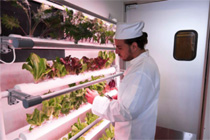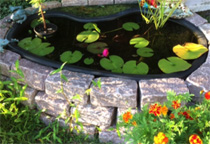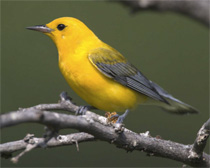Spring 2017 Projects
The William & Mary Committee on Sustainability has announced spring and summer 2017 Green Fee awards. A total of $97,776 has been dedicated to sustainability projects around campus this semester.
The Green Fee fund began as a grassroots student initiative in 2008. Since then, it has funded more than 200 sustainability projects led by students, faculty and staff around the W&M campuses. This semester saw a wide variety of proposals, from campus-wide initiatives to innovative sustainability research projects. Summaries of each of the projects are listed below.
Battery-Powered Leaf Blowers Pilot Project
$2,216 to John McFarlane, Associate Director of Gardens and Grounds
The grounds department currently uses gasoline powered backpack blowers daily to clear walks and curbs of debris and seasonally to sweep fallen leaves from lawns. They are noisy and create exhaust emissions from the backpack-mounted motor. The backpack battery-powered blowers produce no emissions from the equipment and are rated as significantly quieter than gas blowers. Comparisons between the two different types of blowers will be made for noise reduction, ease of use and fuel usage versus battery charging times.
Decreasing Water Usage on the VIMS Campus
$1,2630 to Lydia Bienlien, M.S. ’16, Ph.D. ’20, and advisor Mark Brabham, Director of Facilities Management at VIMS
W&M's Virginia Institute of Marine Science is a world-class research facility that supports over 450 employees and typically receives more than 9,000 visitors each year. To support this community, the campus uses toilets that have a single-flush handle system. This system is inefficient, and funding will be used to retrofit women’s toilets in the larger buildings on campus with a dual-flush handle, saving a half gallon of water per flush. This will decrease water usage on the VIMS campus and reduce costs associated with water treatment. Explanatory signs placed by retrofitted toilets will encourage the use of the water-saving option and raise awareness of the importance of water conservation on campus and throughout the greater community.
Campus Bottle Filling Stations in Collaboration with Take Back the Tap
$40,289 to Gregg Shipp, Director of Operations and Maintenance, Facilities Management
In an ongoing effort to decrease disposable plastic bottle use at William & Mary, the Committee on Sustainability is partnering with student organization Take Back the Tap to fund the continued installation of new refillable water stations throughout the main campus and VIMS. This grant recognizes the high demand for these services, demonstrated by the multiple proposals submitted each semester by varying departments, offices and organizations. This funding makes quick strides towards the goal of at least one bottle filling station per high traffic building on campus, with strategic locations determined by COS, Facilities Management and TBTT.
Compostable Dinnerware
$2,100 to Eden Harris and Janet Yang, Williamsburg Campus Child Care
The Green Fees grant will allow Williamsburg Campus Child Care to pilot converting their entire food program to one that uses compostable dinnerware. Currently WCCC partners with NOPE and W&M Dining Services to compost food waste, but is still using plastic cups and utensils. This Green Fee will allow WCCC to incorporate compostable cups, utensils, bowls and plates to make the entire food program compostable.
COLL 300 Sustainability Speaker
$10,000 to the Center for the Liberal Arts
The Center for the Liberal Arts has chosen sustainability as the theme for spring 2018 COLL 300 courses. Three visitors will frequent the campus that semester, bringing varying perspectives on the topic to the W&M community. This award will help extend an invitation to a major speaker so that they may share their experience and knowledge through an integrated visit to the campus.
Commons Dining Hall Hydroponic Farm
$10,784 to Sam Laveson, Sodexo Dining Sustainability Interns, and advisors Steve Moyer & Jason Aupied
 In the modernized world, people seem to be frequently distanced from the source of their food. In an effort to increase the proximity of food to those consuming it, eight hydroponic Grow Walls will be installed in the Commons Dining Hall. Additionally, the project is intended to reduce air pollution from so many produce deliveries, improve the quality and nutritional value of the produce served, and introduce innovative, sustainable methods for the future of farming to all members of the College community. The Grow Walls will be maintained primarily by Sodexo chefs, but the dining interns team will take charge of the outreach, educational and volunteer aspects of the project.
In the modernized world, people seem to be frequently distanced from the source of their food. In an effort to increase the proximity of food to those consuming it, eight hydroponic Grow Walls will be installed in the Commons Dining Hall. Additionally, the project is intended to reduce air pollution from so many produce deliveries, improve the quality and nutritional value of the produce served, and introduce innovative, sustainable methods for the future of farming to all members of the College community. The Grow Walls will be maintained primarily by Sodexo chefs, but the dining interns team will take charge of the outreach, educational and volunteer aspects of the project.
Swem Paper Reduction Initiative: Pause Before You Print
$1,400 to Emily Gardner, 2017, and advisor Lisa Nickel, Associate Dean of Research & Public Services, Swem Library
It takes one tree to make 16 reams of paper. Last semester, the W&M student body printed approximately 1,177,000 sheets of paper. Over the course of a year, students print nearly 2.5 million sheets of paper. Although the environmental and economic costs of printing will never be completely eliminated, they can be greatly reduced by encouraging students to be more mindful of their printing habits and more conscious of their environmental impact. This project aims to reduce paper use in the Swem Library by creating a targeted message campaign that will visually remind students of paper waste.
Integrated Science Center Courtyard Ponds
$2,382 to Paul Heideman and Matthias Leu, Professors of Biology, and students
 The Integrated Science Center courtyard could be a teaching space, gathering spot and campus gem with the addition of small interactive fish and frog ponds maintained by students supervised by professors. The project will place eight small ponds as examples of ecosystems that can move in and out of ecological balance. The web of connections among ponds will include aquatic insects, birds, and frogs. Signs that include urls and QR codes will link to a student-designed website with explanations, information about ecology and conservation and plans for do-it-yourself construction. The site is expected to be a place for children, students and community members to learn about ecology and conservation.
The Integrated Science Center courtyard could be a teaching space, gathering spot and campus gem with the addition of small interactive fish and frog ponds maintained by students supervised by professors. The project will place eight small ponds as examples of ecosystems that can move in and out of ecological balance. The web of connections among ponds will include aquatic insects, birds, and frogs. Signs that include urls and QR codes will link to a student-designed website with explanations, information about ecology and conservation and plans for do-it-yourself construction. The site is expected to be a place for children, students and community members to learn about ecology and conservation.
Prothonotary Warbler Nest Box Installation
$225 to Courtney Check ’19, Kyle Goeke Dee ’18, and advisor Dan Cristol, Professor of Biology
 Prothonotary warblers are a rapidly declining bird species that does not typically occur on campus. The wetland areas around Lake Matoaka provide an ideal habitat for this species. The installation of specially designed nest boxes at strategic locations around the lake will serve to attract this beautiful bird by providing it with a safe nesting locations. Having this bird on campus will not only help to expand its range, but also foster an appreciation for a declining species and for the natural world.
Prothonotary warblers are a rapidly declining bird species that does not typically occur on campus. The wetland areas around Lake Matoaka provide an ideal habitat for this species. The installation of specially designed nest boxes at strategic locations around the lake will serve to attract this beautiful bird by providing it with a safe nesting locations. Having this bird on campus will not only help to expand its range, but also foster an appreciation for a declining species and for the natural world.
Cleaning of the Crim Dell
$5,250 to Joshua Panganiban '20 and advisor Randolph Chambers, Director of the Keck Environmental Field Lab
The Crim Dell is one of the most scenic sites of the College with its ideal location in the center of campus. One of the concerns of the Crim Dell are the high levels of nitrates coming from runoff. High levels of nitrates are conducive to algae growth, which damages the aquatic ecosystem. This funding provides for the research of a synthesized plastic polymer, a natural organic polymer, to denitrify water coming into the Crim Dell. If the research proves successful, the Crim Dell will become cleaner and more aesthetically pleasing. In addition, new tests can be conducted to add more functionality to the PHA such as a phosphorus-reducing component.
Storm Water Management on Campus
$5,250 to Chenjie Shao '18 and advisor Edwin Pease, Adjunct Instructor of Department of Art and Art History
Storm water always aggregates on lowlands and bothers the W&M community. From an ecological aspect, it influences the process of sedimentation, water quality and overall health of Matoaka watershed. Instead of further installation of water retentions, the goal is to generate a conceptual architectural model that improves the storm water management situation in a way which is specifically suitable to W&M’s unique circumstance. By proposing a way to combine applicable storm water management solutions with building structures and manage the surface runoff aggregated at sites on campus, this research provides a new way of thinking and evokes an innovative discussion about sustainable issues.
Herbarium Digitization Project
$5,250 to Marly Saunders '18 and advisor Beth Chambers, Herbarium Curator
The large-scale digitization of vascular plant specimens in the herbarium is part of ongoing efforts to make this information more accessible to researchers and the general public. This project will invest in research to develop efficient protocols to photograph, barcode, geo-locate and digitize the more than 80,000 specimens in the herbarium. This research will make invaluable data and images of these plants — especially specimens that are unique to W&M's collection — part of large databases and open access to botanical and ecological researchers. Digitization will make the collection more sustainable by significantly reducing damage and decay of the specimens.














